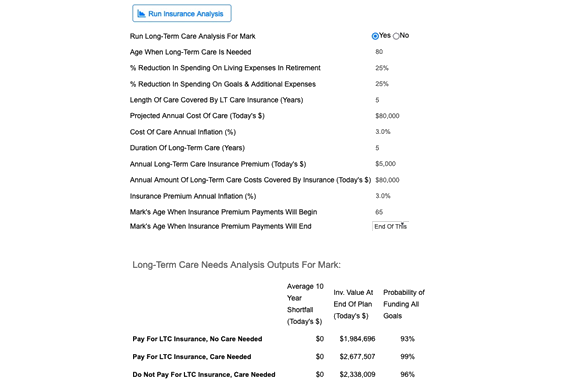Key Points:
- Accounting for long-term care is one of the trickiest parts of putting together a retirement plan.
- The uncertainty regarding long-term care is partly due to mispricing of long-term care insurance policies, which are a relatively new invention.
- Modeling your options for coverage in a program like WealthTrace is critical to understanding whether you are on track for a comfortable retirement.
If you're reading this, you're retired, or close to retirement, or at least thinking about it. Good for you.
How far have you gotten? Are you thinking about all the recreating you'll be doing after your working years? Maybe considering moving to a low- or no-tax state? Planning the home downsizing?
There's one piece of the retirement puzzle that a lot of people tend to put off planning for because it's not much fun to think about.
If you need some form of long-term care beyond assisted living--and about half of us who make it to 65 will--it's going to cost real money.
If you still don't want to think about it and therefore don't even want to finish this article, know these two things: On average, it will cost around $140,000 for long-term care per person, and long-term care premiums are in the $2,700 per year range per person, depending on when the policy is purchased.
Unfortunately those numbers are not super meaningful, because costs vary so much from state to state and because everyone's health and heredity is different. But it's at least a starting point.
How should you plan to handle this potential expense? In a sense, it's like planning for kids' college costs. You don't know where the children will go to school, whether they'll qualify for scholarships or financial aid, and what kind of student loan debt they might take on, so trying to plan ahead for the cost is difficult. But it's partially that difficulty that makes planning for it so important.
So let's get into the pros and cons of buying long-term care (LTC) insurance versus covering the costs yourself, or 'self-insuring.' There are a few ways to approach the issue, and WealthTrace can help in all of them.
A Brief, Incomplete, Opinionated History Of Long-Term Care Insurance
Because LTC policies were something new, they were mispriced. That is, they were underpriced, resulting sometimes in big jumps in premiums for those who purchased them early on. Now, decades on, there are very few insurers left who even offer the policies. They don't want to be burned by the uncertainty of the future costs of end-of-life medical care anymore than their customers do.
Stories of skyrocketing premiums, fights with insurance companies (right when you are least equipped to put up much of a fight), and companies themselves getting out of the business entirely may be enough to scare you off.
If you do still want to buy a policy (and doing so between your early 50s and early 60s is normally best), you have some options to consider. It's no longer just a matter of finding the cheapest policy at a reputable company. We'll spell out some of those options below.
Elimination periods offer flexibility. They're similar to deductibles that you see with other types of insurance. You can estimate what you'd be willing to draw on from your own assets before insurance takes over, and tailor your LTC policy accordingly.
If premiums increase dramatically, you can usually pay less in premiums in exchange for fewer benefits if that becomes necessary. That obviously would not be ideal, but the option is there if you need it. Partial coverage policies are available too. For example, statistically, you are not likely to be in a nursing home for more than three years, so you may want to home in on coverage just for that amount of time (knowing that you're taking some risks if you do).
Whole life policies that can be drawn on for long-term care are also available. These hybrid policies offer more certainty--your premium is locked in, for example--but they are also far more expensive than traditional LTC insurance plans.
If you don't want sons and daughters or other family members to feel like they need to take care of you late in life, LTC insurance might look like a good alternative. But in our opinion, it might make just as much sense to save up for it yourself if you can--that is, to self-insure. Regardless, we'll go over both options below.
Doing The Math
We'll use as an example a couple in their early 50s who want to make sure they're covered, in one way or another, in case they need long-term care. They don't want to burden their adult children with any potential expenses or care duties, and are willing to dip into what they plan to pass on to those children in order to make this happen.
The couple is relatively well-off, with about $1.9 million in investments and modest living expense needs. Their Monte Carlo result, which looks at the probability of success of their plan, is a very comfortable 94% without taking LTC insurance--or covering the potential need for long-term care in some way--into account.
Their first stop, since they have the Deluxe version of the program, is the Scenarios section in WealthTrace. Here, they can run a LTC insurance analysis that will give them a sense of what (1) paying for LTC insurance but not needing it would do to their plan; (2) paying for LTC insurance and needing it would do to their plan; and (3) not paying for LTC insurance but needing such care would do to their plan.

The tool will show the three different results for each plan participant--that is, its main objective is to tell the participant who is not presumed to need long-term care what their results will be.
The tool will show the three different results for each plan participant--that is, its main objective is to tell the participant who is not presumed to need long-term care what their results will be.
The tool will show the three different results for each plan participant--that is, its main objective is to tell the participant who is not presumed to need long-term care what their results will be.
The tool will show the three different results for each plan participant--that is, its main objective is to tell the participant who is not presumed to need long-term care what their results will be.
The long-term care insurance scenario is a great starting point for trying to get their arms around the issue. Once they've run those numbers, it's time to model them in a plan.
This Year's Models
First, they plan to model paying LTC insurance premiums. In this case, they model a $5,400/year policy for the two of them (based on the $2,700 per-person average mentioned above) as a standard-pay policy, which means the payments continue until the end of their lives, and that premiums can be increased.
And that premiums can be increased. That's the wildcard here.
If we model the $5,400 expense as simply increasing by the inflation rate each year, their Monte Carlo results drop to a still-tolerable 90%.

But if we add a rude-awakening-level annual increase of 2.5% above our inflation rate...

That's a fairly substantial drop--and such an increase in premiums is quite possible.
That's one way to think about the issue: Can I pay the premiums, and am I prepared to continue to pay them if they grow faster than inflation? WealthTrace can help model that.
Another way to incorporate long-term care into a plan is to try to come up with a figure for what self-insuring might cost you. That is, are you able to squirrel away--and essentially earmark--enough money to handle the costs of long-term care yourself?
It's really just a different way of looking at and handling the same thorny issue, but it might be easier for some people to conceptualize it this way. Plus, with WealthTrace, you can see what the projected balance of the account will look like over time, taking into account the contributions as well as the total returns of the asset classes in which it is invested.
Our couple is first going to try modeling contributions of that $5,400 figure for 25 years (even though they're not actually paying premiums), growing at inflation, and invested in cash.

Since they are already retired, the program needs to know how the contributions will be funded. (If they were still working, the contributions would be assumed to come out of their salary.) So we'll set up a withdrawal from a taxable account, also going 25 years.

In taking a look at the projected balance of the account, though, they realize this plan won't cut it: They'll only have about $45,000, when they'll need around $280,000 for both of them (per the conventional wisdom about what care will cost per person on average if they pay out of pocket).

Investing in a more aggressive asset class mix to bump up their returns helps substantially, but it still doesn't get them anywhere close to that figure:

This means the couple will have to either make some further adjustments (like increasing contributions), or come up with the balance from somewhere else. If they choose the former, they can test it out in WealthTrace using its sliders, which allow them to see what the effect of certain changes would be in real time without actually committing those changes to a plan.

Be Prepared
As with everything else we insure ourselves for, with long-term care, there's so much we don't know: If we'll need it, when we'll need it, for how long we'll need it, how much of the cost will be covered if we need it, and so on. With LTC insurance, you have some additional complicating factors too, like whether your premiums will go up over time, or even if the insurer will continue to write such policies.
So then it becomes a question of probabilities. We do what we can to plan for the worst and hope for the best, but the 'plan' part of that saying is especially important here.